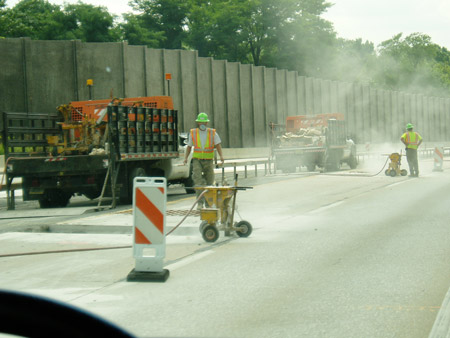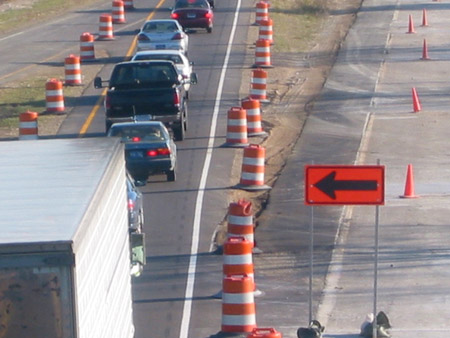U.S. Department of Transportation
Federal Highway Administration
1200 New Jersey Avenue, SE
Washington, DC 20590
202-366-4000
Focus
| Accelerating Infrastructure Innovations |
Publication Number: FHWA-HRT-11-011
Date: March 2011
Printable Version (.pdf, 1 mb)
"Safer driving. Safer work zones. For everyone." With the goal of reminding drivers how important it is to keep highway workers, themselves, and their passengers safe, National Work Zone Awareness Week (NWZAW) 2011 will kick off April 4 with an event at the Intercounty Connector project site in Maryland. In 2009, 667 workers and motorists were killed in highway work zones and more than 40,000 were injured. "We want to get the message out to the public that 85 percent of those killed in work zones are drivers and their passengers. How they drive in work zones has a direct impact on their own safety, as well as the safety of workers," said Chung Eng of the Federal Highway Administration (FHWA).
NWZAW began in 1999 when FHWA, American Traffic Safety Services Association (ATSSA), and the American Association of State Highway and Transportation Officials signed a Memorandum of Agreement pledging to increase public awareness of work zone safety issues through a national media campaign. Since then, agencies and organizations around the country have sponsored high-visibility outreach efforts, including "Go Orange" campaigns in numerous States, where public buildings are lit in orange and citizens are encouraged to wear the color to show support for NWZAW. In California, fallen workers are honored at an Annual Workers Memorial. Tennessee, meanwhile, has sponsored a "Between the Barrels" education initiative for teenagers, while the Virginia Department of Transportation (VDOT) has urged drivers to consider work zones "no phone zones." Virginia has also established the VDOT Workers Memorial on Interstate 64.
Supporters of this year's event include State transportation departments, the American Road and Transportation Builders Association (ARTBA), and the Associated General Contractors of America. More details about NWZAW 2011 will be posted at www.atssa.com and www.ops.fhwa.dot.gov/wz/outreach/wz_awareness.htm as information becomes available.
"We want to get the message out to the public that 85 percent of those killed in work zones are drivers and their passengers." |
For work zone safety resources, States, contractors, and others can turn to products developed through FHWA's Work Zone Safety Grant program. From 2006 to 2009, $17.2 million in grant funds were distributed to provide highway work zone safety training and develop guidelines to prevent and reduce work zone injuries and fatalities. Grants were competitively awarded to the Laborer's Health and Safety Fund of North America/ARTBA, ATSSA, Wayne State University in Michigan, and the Illinois Institute of Technology.

The goal of National Work Zone Awareness Week 2011 is to remind drivers that safer driving means safer work zones for everyone.
A wealth of guidelines, products, publications, and training resources are now available for States and contractors to use, including more than 40 guidelines and publications, 24 training modules, and 2 software applications. Approximately 46,000 workers across the country have benefited from training developed through the grant to date.
Available products range from the Work Zone Positive Protection Toolbox to Guidelines on Managing Speeds in Work Zones to a field guide on Work Zone Safety: Temporary Traffic Control for Maintenance Operations. A series of pamphlets looks at such topics as operator safety, flagger safety, electrical hazards, and night work risks. Training materials, meanwhile, range from presentations on the "Safe Installation and Removal of Traffic Control Devices" and "Shadow Vehicles for Work Zones" to complete suites of training products, including the "Roadway Safety + Basic Awareness Course" and "Roadway Safety + Runovers/Backovers Course." For a complete list of the products and resources available and information on how to obtain them, visit www.workzonesafety.org/fhwa_wz_grant.
FHWA also offers a Work Zone Safety and Mobility Peer-to-Peer (P2P) program, which matches agencies with experienced transportation professionals who can provide guidance on how to address common challenges in implementing work zone management strategies. To be matched with a peer, call 866-P2P-FHWA (866-727-3492), or send an email to workzoneP2P@dot.gov. There is no cost to participate in the program.
Detailed work zone safety resources are posted online at the National Work Zone Safety Information Clearinghouse (www.workzonesafety.org). This one-stop "cyber library" provides comprehensive information on laws and regulations, best practices, current research, products, public awareness campaigns, and training materials. Some resources are available in languages other than English, including French, Spanish, Russian, Arabic, Chinese, and Japanese.
To learn more about FHWA's work zone safety and mobility resources, visit www.ops.fhwa.dot.gov/wz. Information is also available by contacting Chung Eng at FHWA, 202-366-8043 (email: chung.eng@fhwa.dot.gov).

For work zone safety resources, States and contractors can turn to products developed through FHWA's Work Zone Safety Grant program, including guidelines, publications, and training modules.